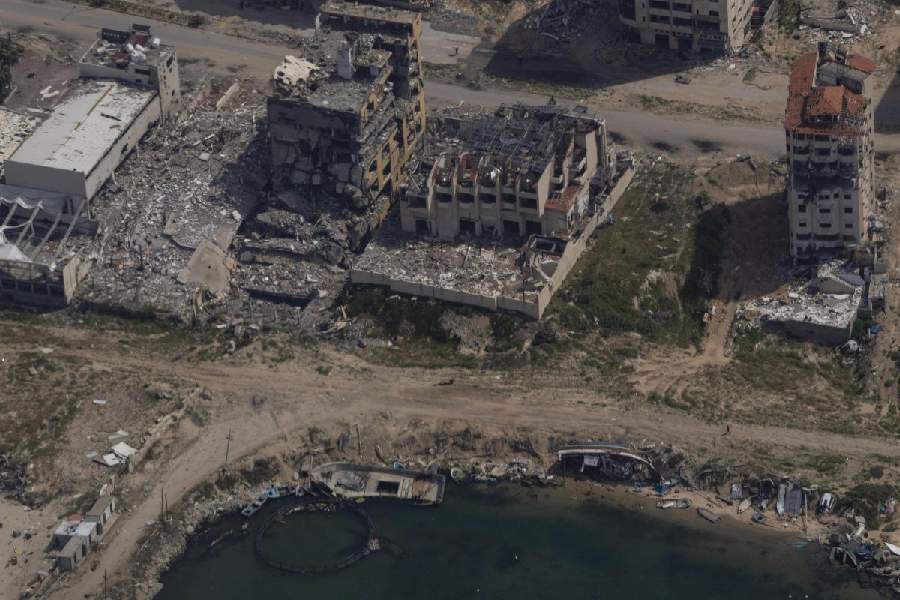The amount of aid reaching the Gaza Strip has fallen sharply since the start of Israel’s war with Hamas, leading to what humanitarian officials say is a catastrophe for the territory’s population of more than 2 million people. Gaza was subject to a blockade before the Oct. 7 attack on Israel, but around 500 trucks of food and other supplies a day were still crossing into the territory. That number has since fallen by around 75%, according to United Nations data.
Here is a look at the ways aid is getting into Gaza:
Road
Roads are by far the most important delivery route: More than 15,000 trucks of aid have entered the territory since Oct. 7 at two entry points in the enclave’s south. Most have entered through Rafah, on Gaza’s border with Egypt. The other point is at Kerem Shalom, an Israeli crossing. Since January, protesters have sometimes blocked the Kerem Shalom crossing, arguing that Gaza should receive no aid while armed groups still hold captives taken on Oct. 7. Aid groups have called for more crossings to be opened.
Israel subjects all aid for Gaza to rigorous checks, saying that it is attempting to block items that could potentially be used by Hamas. Britain’s foreign minister, David Cameron, said this week that too many goods were being turned away on those grounds, echoing the stance of officials at aid agencies and the United Nations.
Col. Elad Goren, an official at Israel’s agency that oversees policy for the Palestinian territories, known as COGAT, told reporters Thursday that almost all of the trucks that enter inspection are approved and only a tiny fraction are turned back because of the presence of “dual-use” items, or those with both civilian and military purposes.
Israeli officials say that there is no limit to the amount of aid that can enter Gaza by road, and that responsibility for bottlenecks lies with aid agencies. They say that they can inspect more aid deliveries than humanitarian organizations can process and distribute.
Even after supplies get into Gaza, aid groups have struggled to make deliveries because of security challenges — and particularly to transport goods to northern Gaza from entry points in the south. The north of the territory is on the brink of famine, according to the United Nations’ World Food Program. This week, Israel allowed the agency to send an aid convoy with food for 25,000 people directly into northern Gaza through a crossing point that had not previously been used for aid during the war. The agency said it was the first time since Feb. 20 that it had delivered food in the north.
Sea
The United States, Britain, the European Union and other governments announced last week that they would establish a sea route for aid to Gaza from Cyprus, and the U.S. military has announced plans to build a floating pier to facilitate deliveries because Gaza does not have a functioning port.
A ship carrying 200 metric tons of aid from the charity group World Central Kitchen departed Cyprus for Gaza on Tuesday in what European officials called a pilot project for the new route. The group is building a makeshift jetty in Gaza to unload the aid, which had not yet arrived as of Thursday.
A second ship was being loaded in Cyprus on Thursday with 300 metric tons of aid, the World Central Kitchen said, but it was not clear when it would set sail.
U.S. officials have said it could take 30 to 60 days to build the floating pier. Aid groups and Gaza officials have said that sea shipments and airdrops are both slow and cannot come close to supplying as much as trucks.
Air
This week Germany became the latest country to announce plans to airdrop aid to Gaza, after the United States, Jordan, the United Arab Emirates, Egypt and France. The Israeli military said Thursday that 1,000 aid packages had been airdropped into the Gaza Strip over the past week. The drops could ease delivery to parts of Gaza out of reach of aid trucks. But aid officials say it is costly and ineffective as a means of delivering large quantities of supplies.
It is also risky for civilians on the ground. Local authorities said last week that at least five Palestinians were killed after airdropped aid packages fell on them in Gaza City.
The New York Times News Service











